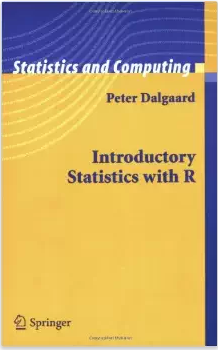Introductory Statistics with R

Author: Peter Dalgaard
"Has been a key member of the R Core Team since August 1997 and is well known among R users for his activity on R"
Published: January 9, 2004 by Springer
Summary: This book provides an elementary-level introduction to R targeting both non-statistician scientists in various fields and students of statistics. The main mode of presentation is via code examples with liberal commenting of the code and output, from the computational as well as the statistical viewpoint. Supplementary R package can be downloaded that contains the data sets.
The book includes examples of statistical standard deviations, one- and two- sample tests with continuous data, regression analysis, one- and two- way analysis of variance, regression analysis, analysis of tabular data and sample size calculations. In the last chapters includes multiple linear regression analysis, linear models in general, logistic regression, survival analysis, Poisson regression and nonlinear regression.
For preview of the book, click here
To buy book or specific chapters, click here